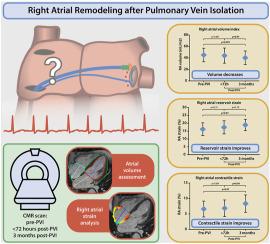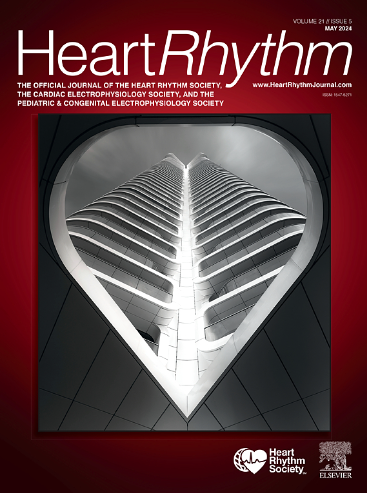Right atrial reverse remodeling after pulmonary vein isolation: Analyzing changes in volume and function using cardiac magnetic resonance imaging
IF 5.7
2区 医学
Q1 CARDIAC & CARDIOVASCULAR SYSTEMS
引用次数: 0
Abstract
Background
Successful pulmonary vein isolation (PVI) promotes left atrial (LA) reverse remodeling, but its effect on right atrial (RA) remodeling remains unclear.
Objective
The purpose of this study was to assess the impact of radiofrequency (RF) PVI on RA volumes and function in patients with atrial fibrillation by using cardiac magnetic resonance imaging.
Methods
Forty-three patients with atrial fibrillation (32 (74.4%) males; mean age 61±7 years) undergoing first RF PVI, without atrial flutter ablation, underwent 3 cardiac magnetic resonance scans: pre-PVI, early (<72 hours) post-PVI, and 3 months post-PVI. Indexed atrial volumes (RA maximal/minimal volume index and LA maximal/minimal volume index) and function were derived from 2- and 4-chamber cine images, with longitudinal atrial strain analyzed using feature tracking.
Results
Early post-PVI, RA minimal volume index significantly decreased (from 28.7±10.3 to 26.0±9.9 mL/m2; P=.03) while RA emptying fraction significantly increased (from 37.3%±11.5% to 41.7%±10.1%; P=.03). At 3 months, both RA minimal volume index and RA maximal volume index showed further significant reductions compared with baseline (from 28.7±10.3 to 24.8±8.8 mL/m2; P=.002 and from 45.2±11.8 to 40.3±11.9 mL/m2; P<.001, respectively). During this period, RA functional improvement persisted, as evidenced by RA reservoir and contractile strain (from 16.2%±4.1% to 18.9%±3.6%; P=.003 and from 6.6%±2.6% to 8.3%±2.8%; P=.005, respectively). LA volumes remained unchanged early post-PVI, but at 3 months, LA maximal volume index significantly decreased compared with baseline (from 46.1±13.0 to 39.1±11.3 mL/m2; P<.001). LA function, demonstrated by reservoir and contractile strain, was significantly diminished early post-PVI, which persisted at 3 months compared with baseline (from 18.6%±4.0% to 17.0%±3.4%; P=.04 and from 8.5%±3.0% to 6.9%±2.4%; P<.01, respectively).
Conclusion
This study demonstrates that RF PVI results in reverse biatrial remodeling, with significant reductions observed in RA and LA volumes. RA function showed a significant improvement post-PVI, while LA function demonstrated persistent impairment at 3 months, possibly because of LA ablation scarring.

肺静脉隔离后右心房反向重构:利用心脏磁共振成像分析其体积和功能的变化。
背景:成功的肺静脉隔离(PVI)促进左房(LA)的反向重构,但其对右房(RA)重构的影响尚不清楚。目的:通过心脏MRI (CMR)评估射频(RF) PVI对房颤(AF)患者RA体积和功能的影响。方法:43例房颤患者(74.4%,男性,61±7岁)首次行射频PVI,无心房扑动消融,分别行PVI前、早期(结果:PVI后早期,RAVImin显著降低(28.7±10.3mL/m2至26.0±9.9mL/m2,p=0.03)、RA EF显著升高(37.3±11.5%至41.7±10.1%,p=0.03) 3次CMR扫描。在3个月时,与基线相比,RAVImin和RAVImax均显示出显著的进一步降低(28.7±10.3mL/m2至24.8±8.8mL/m2,p=0.002;结论:射频PVI可导致双房重构逆转,RA和LA体积明显减少。pvi后RA功能明显改善,而LA功能在3个月时表现出持续的功能受损,可能是由于LA消融瘢痕。
本文章由计算机程序翻译,如有差异,请以英文原文为准。
求助全文
约1分钟内获得全文
求助全文
来源期刊

Heart rhythm
医学-心血管系统
CiteScore
10.50
自引率
5.50%
发文量
1465
审稿时长
24 days
期刊介绍:
HeartRhythm, the official Journal of the Heart Rhythm Society and the Cardiac Electrophysiology Society, is a unique journal for fundamental discovery and clinical applicability.
HeartRhythm integrates the entire cardiac electrophysiology (EP) community from basic and clinical academic researchers, private practitioners, engineers, allied professionals, industry, and trainees, all of whom are vital and interdependent members of our EP community.
The Heart Rhythm Society is the international leader in science, education, and advocacy for cardiac arrhythmia professionals and patients, and the primary information resource on heart rhythm disorders. Its mission is to improve the care of patients by promoting research, education, and optimal health care policies and standards.
 求助内容:
求助内容: 应助结果提醒方式:
应助结果提醒方式:


